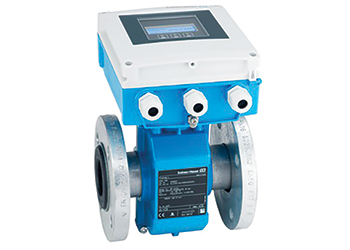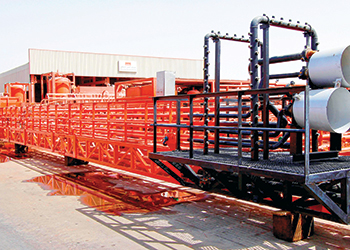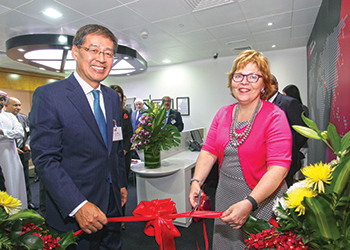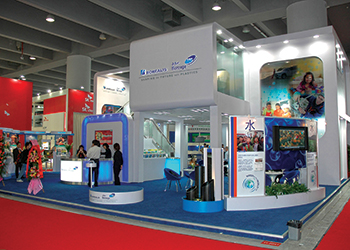
 Proline Promag L flowmeter with Heartbeat Technology
Proline Promag L flowmeter with Heartbeat Technology
Enhanced self-diagnostic capability in the ‘smart flowmeter’ takes safety, efficiency and plant availability to unprecedented levels, says HANS-JOACHIM FROEHLICH of Endress+Hauser Flowtec
In oil and gas operations, and petrochemical companies alike, safety is of highest importance. Consistent quality and accurate billing of products are top priority as well. There is also an increasing need to prove that the operation meets environmental regulations. Consequently, all measuring technology must ensure maximum reliability.
State-of-the-art flow sensors are free of wear and tear, which is critical to ensuring these values. They have been recognised not only for highly stable measurement outcomes over long periods of time, and robustness under demanding operating conditions, but also for convenient and traceable techniques in terms of proving and periodic testing.
More recently, the consequent use of their greatly enhanced self-diagnostic capability has made flowmeters 'smart' about their own condition, and paved the way to minimise effort and exposure for the personnel involved in routine activities such as proof-testing. Compliant verification reports enable longer calibration intervals and better plant availability overall. Remote access to comprehensive diagnostic information prevents unplanned shut-down, or unnecessary and risky on-site intervention.
Backbone of the development for Endress+Hauser’s Proline flowmeters is a rigorous 'Safety-by-design' concept based on IEC 61508 standards for functional safety, with the goal to minimize the risk of dangerous-undetected failure, and to attain best-in-class safety and reliability marks. A technical concept named Heartbeat Technology constitutes a test method integrated in the flowmeter, which encompasses Heartbeat Diagnostics and Heartbeat Verification, both relying on internal factory-traceable references which are redundantly reproduced in the device.
Heartbeat Diagnostics ensures broadest diagnostic coverage with no gaps left from the sensor frontend to the outputs. Diagnostic status information according to NAMUR NE 107 may be transferred to higher-level systems by digital field protocols. Clear-text indication and remedy are associated with each error code and stored in the event logbook for the device. Targeted service intervention can therefore be carried out on such a device with minimal time and cost involved.
Heartbeat Verification verifies the function of the flowmeter on demand by using the same embedded technology, to satisfy requirements for periodic testing as specified in operating procedures, or whenever needed by the operator. The total test coverage (The total test coverage is defined by a Failure-mode-evaluation-and-diagnostics analysis (FMEDA) according to IEC 61508 as the ratio of potential failure detected and likewise mitigated versus the total probability of random failure in the device electronics) typically ranges from 95 per cent to over 98 per cent, depending on the device type.
Most of the common digital field network protocols support at least a verification to be initiated remotely and a Pass / Fail statement to be transferred back to the control system, or an asset management system, respectively.
Technical auditors and regulators affirm compliance of Heartbeat Technology with the requirements for traceable verification according to DIN EN ISO 9001:2008 – (Section 7.6 a) 'Control of monitoring and measuring equipment'. Key to this conclusion is a continuous cross-check among the device-internal references, which allows detecting any drift immediately, and likewise ensures the references remain stable for both measuring and testing procedures.
The 'as-manufactured' condition of the device-internal references is captured during factory calibration in an accredited facility according to ISO 17025, and is securely saved in the meter’s nonvolatile memory. This reference information forms the basis for consecutive internal verifications over the lifetime of the flowmeter.
During verification, the current flowmeter condition expressed in a large variety of secondary parameters is compared with the reference values, thereby determining the actual device status. The individual test results are securely stored in the meter memory. They are used to compile a verification report, which allow the device to document its health condition in an incorruptible manner. The report can be used for quality documentation as an evidence of conformity with legal standards.
An increasingly important application for Heartbeat Technology is in safety-instrumented systems designed, implemented and operated according to functional safety standard ISO 61511. By the unparalleled low failure ratings provided by Heartbeat Diagnostics, Proline flowmeters may be used for many years before they have to undergo a full proof-test. In the meantime, Heartbeat Verification can be used to document the functionality in a quick and virtually effortless manner in case a partial proof-test is performed on the SIL-rated loop.
The traditional method of verification with traceable, external proving tools is no longer necessary. As a result, regulators usually agree the intervals between labor-intensive recalibrations can be extended. The advantages of this process include significant time and cost savings, while virtually eliminating risks associated with incorrect handling.
Thanks to the standardised implementation across a wide variety of measurement technologies, users of Proline flowmeters from Endress+Hauser need to learn only once how to work with this method, resulting in cost savings through increased productivity in operation and maintenance.



















































































